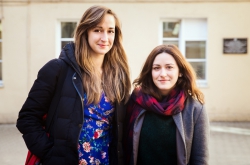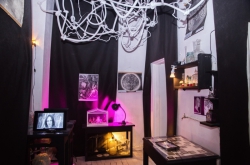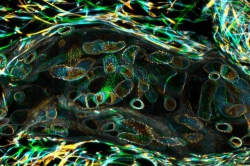In the recent years, Denmark has experienced a boom of interest in modern art: new, daring galleries keep on opening up in Copenhagen and beyond. Take, for instance, the Your Rainbow Panorama project at ARoS Aarhus Art Museum; it’s a circular walkway covered with glass of all colors, inspired by Dante Alighieri’s “Divine Comedy”. Indeed, the 9 Rooms gallery in the museum’s basement hosts light and video installations bound to evoke images of hell.
Each year Danish lighting designers present their projects at Northern Europe’s largest music festival in the town of Roskilde. Lighting design is gradually moving outside of modern art and becoming a part of everyday life. How can lighting in hospitals and retirement homes be used to improve the residents’ well-being? Can light help school children attend classes with more enthusiasm and learn the material better? These are the questions that students of the Master’s program in Lighting Design at Aalborg University try to answer. According to PLDR Awards 2017, this is the best educational program in lighting design in all of Europe.

Aalborg University
Founded in 1974, it is one of Denmark’s top universities and is among the top 5% of the world’s universities. Out of the university’s 20,000 students, every 7th comes from abroad. The international program Lighting Design is one of the most multinational and includes students of nearly 30 nationalities. It was launched in 2013 at the university’s Department of Architecture, Design, and Media Technology.
Last year the department joined ITMO’s Higher School of Lighting Design in the creation of an international educational program, slated to launch in 2019. Some of the classes, taught in English, will start this fall. In order to decide on the structure of the educational process and research methods, the partners have met several times throughout 2017; this spring, they’ve organized a student exchange program to help students with their theses and help them familiarize themselves with various research and project approaches.
Two Master’s students from ITMO, Valeria Lukinskaya and Dmitry Chukhin, participated in a two-week internship in Copenhagen as part of ITMO University’s short-term academic mobility competition. Two Master’s students from Denmark are also currently interning at the Higher School of Lighting Design.
Studying in Denmark
As Valeria Lukinskaya explains, one of the main advantages of studying in the program is its human-centric approach and how it focuses on current industry needs as well as relevant social issues. All projects that Master’s students work on are requested by particular customers.
“The curriculum at Aalborg University is very intense. You learn theory at the same time as you work on actual commercial projects. Students there get to understand what’s “in” on the market right now and, when they’ve graduated, can boast a great portfolio that’ll make finding a job that much easier.”
In the prior years, among other projects, the students helped develop a dynamic lighting project for the bridge that connects two of the university’s buildings in Copenhagen.

This year, one of the student projects focused on the development of a lighting concept for the square in front of the St. Nicholas Church in Copenhagen. The project was requested by the Nikolaj Contemporary Arts Center, which occupies the former church.
Why was it necessary to change the existing lighting? The square, which was formed over a hundred years ago, is now completely surrounded by historical buildings. The tall church tower, hanging over the small square, prevents observers from being able to fully take in the historical environment of the area. One possible solution is to redesign the way the area is lit – and update the existing lighting. Developers say that the new project will help attract more visitors and make their time in the square more pleasant. The best proposal will be chosen in May.
What’s also interesting about studying at Aalborg University is that students all work in interdisciplinary teams. All sorts of specialists apply to Master’s programs: industrial designers, architectural designers, engineers and IT specialists. Each project is assigned several teams of four or five members who spend an entire semester developing a solution. In the next semester, the groups and projects change, which lets students experience working with colleagues of different backgrounds, mentalities, and cultures, developing their communication and creative thinking skills. This method, says Dmitry Chukhin, allows for a complex approach to development and creation of rational solutions.

Among the other projects done by students at Aalborg University are practical assignments with a goal to improve others’ quality of life. For instance, one of the students is currently working on a dynamic lighting system with a specific spectral distribution for recreational areas in retirement homes. Being in such areas can help reduce the stress levels among patients suffering from dementia. Another team is finding ways of using natural lighting systems in educational space, working with the students’ circadian rhythms to help them better concentrate on their studies.
“There are many lighting scenarios for classrooms; for example, if it’s a lecture, the light can be amplified to bring attention to the lecturer. Or, inversely, we can reduce light levels in an area with an interactive blackboard or a projection screen. Finally, when the students are doing a test, we can provide evenly spread lighting to help them avoid distractions,” – explains Valeria Lukinskaya.
Making the most of natural lighting
But how does one provide lighting for schools in the northern countries, which suffer from a lack of natural light in wintertime? This is a question Valeria Lukinskaya aims to answer in her Master’s thesis. She is working on a hybrid parametric lighting system that would maximize the amount of natural light and imitate it when it’s no longer available, making it so that the change in lighting sources is unnoticeable and pleasant.

“Right now I’m testing the different hypotheses, making calculations and outlining the criteria by which I will evaluate how well the children react to the light, as well as identifying the parameters of different lighting levels in educational spaces,” – she says – “If my hypothesis is right, then this hybrid model can be integrated in regular schools with very little modification required.”
Dmitry Chukin, too, is developing a hybrid parametric system, but using St. Petersburg’s well-known “well courtyards” as the subject. As the student notes, his project would be relevant not only in northern countries but in many other historical parts of Europe.
“The urban development here is often quite dense, meaning that daylight has difficulty getting into the courtyards and the lower floors,” – he says – “In my work, I’m trying to find ways of working around this and I’m developing a model of the system. Both natural and artificial lighting will be used to increase the quantity of light and let us create different light scenarios.”

During their internship, the Master’s students had the opportunity to consult with Ellen Kathrin Hansen, a top expert on natural lighting, Ph.D., and head of the Lighting Design program at Aalborg University. They add that working with international specialists has not only helped them reconsider the research methods currently used in Master’s theses but also to establish connections which would be beneficial for future research. In the near future, the students also plan to release a scientific article they co-authored with Prof. Hansen.





